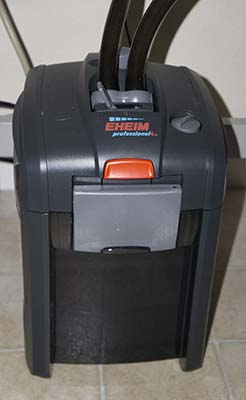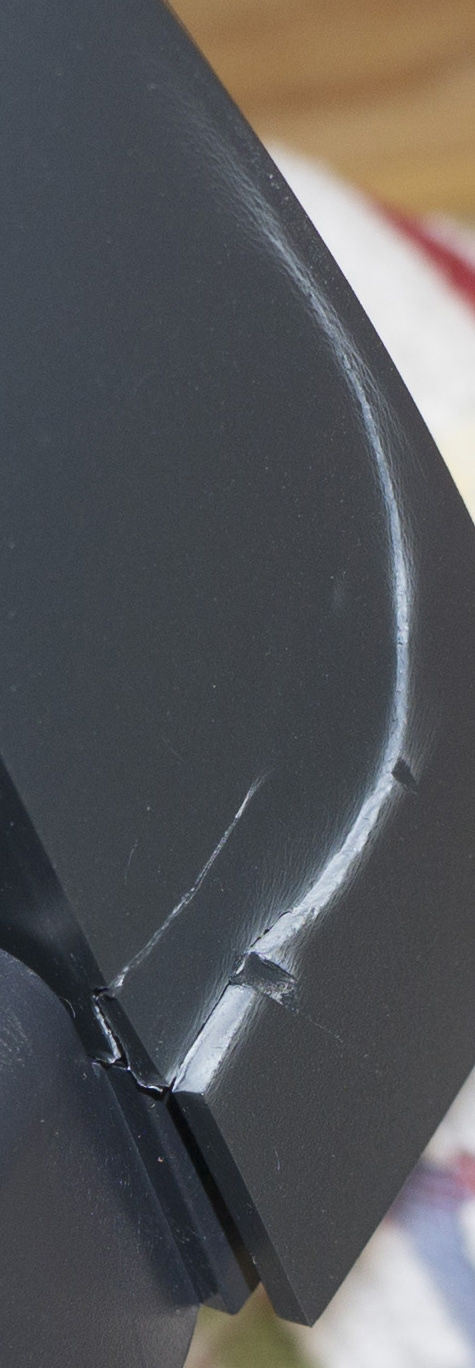Eheim Professionel 4+ — model 250 — aquarium canister filter — a review
© 2018 Peter Free
22 February 2018

Review opinion — summarized
The Eheim Professionel 4+ 250 canister aquarium filter works reasonably well. But cheap plastic construction and arguably minor performance glitches detract in view of its comparatively high price.
Test conditions
I have been using the Eheim Professionel 4+ (250 size) in a nominally 40 gallon all-in-one aquarium — an Innovative Marine Nuvo Fusion 40 — for about three months.
I say "nominally" (with regard to tank size) because if you calculate volume from the tank's actual dimensions, it comes out to be about 34 gallons — when filled to the depth that most users would use it.
With regard to choosing an appropriately sized Eheim filter, I calculated that the water-displacing volume the aquarium's substrate and hardscape. Subtracting both brought the water total down to roughly 26 to 27 gallons.
Canister's mostly good points
The Eheim is quiet. I cannot imagine anyone complaining about its noise out of the box.
On the other hand, after only four cleanings, I noticed that my 250 began to make audible pump noise, when its flow rate lever is switched to the off position.
I am wondering whether an electrical shut-off switch in the pump has failed, and now the pump continues to push water against the closed outflow.
This is one of the negative traits (from a list of such) that led me to conclude that the Eheim canister is better in concept than it is in execution.
Also on the positive side, a push pump button begins the siphon filling process efficiently.
Filtration flow is adjustable from none to full.
Media trays have handles on two sides. You can lift each tray out for cleaning. The trays also have a triangle-shaped marker in one corner. These triangles visually guide proper alignment. A nice touch.
The top of the unit includes the motor and impeller. Although it does not have an alignment mark, physical projections on its underside only fit the correct way into the top media tray. Nice.
Another welcome touch is the push button ease with which one can disconnect the intake and outlet valve block from the canister for cleaning purposes. This convenient disconnect allows the aquarist to move the canister out from under the aquarium stand (or wherever it is) to clean it.
Mild criticisms
Glitches include:
my sample sometimes does not remove visibly swirling bits (of this and that) from the water column or (for that matter) its surface — this may partially be the result of my aquarium's all-in-one design
variable flow control is less than repeatably precise
the four clamps that hold the top in place are not ergonomically well designed
my 250's top cover cracked in a radiating way, when routinely clamping it back into place during the canister's second cleaning
filter trays hold onto enough water to make spillable messes, when one removes them from the still-filled canister for maintenance
and
the Eheim's mechanical and biological filter media should be bagged but are not.
Let's take these criticisms in order.
Macro filtration (on mine) is oddly deficient in some respects
On the positive side, the filter appears to remove very tiny particles that cloud water. For example, during the first canister cleaning, I noticed that the 250's sponge had picked up very fine black dust from the aquarium's CaribSea Tahitian Moon sand substrate.
That positive accounted for, the filter sometimes ignores small fragments of plant debris caught in the water column current.
Perhaps the Nuvo Fusion tank's all-in-one design — with the 250's intake located inside the built-in sump at the back of the aquarium (rather than inside the aquarium proper) — reduces return flow too much to suck these larger pieces into the sump area.
Note
The 4+ is understandably useless in removing floating traces of oil-like organics from the water surface.
Since I did not expect it to get these, I do not consider that a flaw.
Variable flow control is less than repeatably precise
Part of the attraction of the 4+ series is its variable flow feature. My review tank is home to a betta fish. Bettas do not like much in the way of water current. Eheim's adjustable flow feature was attractive for that reason.
I chose the smallest Eheim 4+ because I was concerned that the larger units might move too much water, at any repeatable setting, for the betta's liking.
With the 250, I noticed that trying to reproduce in-between flows (meaning between full and none) is hit and miss. The flow control lever appears to work differently going from full to none than it does from none to full.
This means that going too far going in one direction results in different rates of flow than correcting and going in the other. As a consequence of this trait, I just leave the 250 on full flow. The betta has learned to circulate around the tank, away from the spray bar-induced current. When it wants to rest, plants and hardscape provide hiding spots.
I am also not sure that the same flow lever positions, in either direction, exactly recreate previous settings that occurred in the same lever position.
I had anticipated this lack of precision and do not think of it as being more than a trivially negative trait. I mention the flow control vagueness for the few aquarists to whom it might matter.
Foolishly designed top lid clamps
These clamps are the pull-up-on-the-bottom and then lift-off-the-top type.
Unlike every other version of this design that I have used, the Eheim clamps require you to put your fingers at their corners (rather than the center) to get the process started. There is a solid case projection at the middle (under the clamp) that prevents proper grip.
This arguably inept implementation makes the unclamping process slower and less intuitive than it should be.
You revisit this trait 8 times, when you remove and replace the lid.
Thin, cheap plastic — resulted in a cracked top cover
One of the corners of my 250's cover cracked, under no more pressure than simply reclamping the lid back onto the canister. On the positive side, these cracks have not yet resulted in leaks.

In examining the complex of cracks, I noticed that the plastic is apparently too thin (or not resilient enough) for the pressures it is supposed to withstand.
The material appears to be stressed right out of the molding process. One of the loose edges of the (now split) plastic resisted being pushed back together with its other edge, despite the fact that there was no obstacle in its way.
The corner molding process evidently had incorporated pronounced splitting stress into the material. Eheim's plastic is, evidently, sometimes not strong enough to resist this force, during ordinary use. Notice the stress-caused discoloration emanating from one of the cracks vertically up into the remaining plastic.
This materials weakness is the only aspect of the 4+ that significantly disappointed me.
A manufacturing fix would use thicker or more resilient plastic.
Filter trays hold too much water when removed — a characteristic that is not ideal for cleaning purposes
Cleaning the 4+ requires removing its filter trays and then dumping the remaining canister water.
Although lifting the trays out of the canister is easy, the trays hold onto a fair amount water. Residual water does not reliably drain back into the canister, even when tilted. Yet this excess variably splashes onto the floor, when one goes to put the tray into a bucket for cleaning.
Perhaps Eheim was cost-cutting its engineers, as well as its materials.
Tray media should have been bagged —but were not
In addition to its "fine and coarse filter pads" — the 250 arrives with:
(i) "MECHpro" — which are small spiral-shaped plastic tubes designed for mechanical and biological filtration
as well as
(ii) "SUBSTRATpro" — which are "pearl-shaped sintered glass" biological filtration granules.
The plastic MECHpro tubules float. When you remove the top two media trays (which sit above the tray containing these tiny plastic tubes) — the MECHpro pieces float upward and then around in the case water. Unlike the tray above it, there is no lid on the MECHpro tray.
These elusive tubes have to be corralled, before you dump the canister water. If you don't get them all out, you will be sending some of them down the sink drain. Additionally, some of the tubes invariably find their way to a location beneath the removed tray. One needs to remove them from there, so as to fit the cleaned tray back into place.
The glass SUBSTRATpro media, on the other hand, do not float. But they are small enough that they manage to grittily wedge themselves where they should not be, while one fiddles with the 250's other trays.
Media bags would have solved these foibles. Eheim was (and presumably still is) just being cheap.
Are you beginning to intuit a theme?
An aside regarding the number of filter media trays
The 250 is the smallest of the 4+ series. It comes with 3 media trays.
The next larger size has 4.
And the biggest (the 600) holds 5.
I recognized in retrospect that I would have been happier with 4 trays. When I went to add another kind of media to my 250, there was not room for it. I had to remove half the MECHpro tubes to make the additional media bag fit.
This lower capacity might matter to some users. Percentage-wise, a 4 tray setup would have required a smaller reduction in the nitrogen cycle bacterial colony that had to be removed in my 3 tray arrangement to make room for a silicate reducer.
Note
To be safe with respect to preserving the tank's recently completed nitrogen cycling process, I put the removed MECHpro tubes into a media bag and stuffed that into one of the filter compartments at the back of the all-in-one test tank.
This is not at a criticism of the 250. Obviously, the smaller canister has to have fewer trays to remain manageably small.
Not so refined post-cleaning and power off behavior
One of the mildly annoying canister traits is its predilection for spewing previously filtered detritus back into the aquarium (a) after cleaning and (b) when power is restored after an electrical outage.
In both instances, you will see the entire water column fill up with swirling garbage. It takes the canister a few hours to remove these messes.
An obvious way to prevent detritus regurgitation would be to replace all the canister's media with new media, at each cleaning. That, however, would be prohibitively expensive. And it would also remove all the nitrogen-cycle bacteria that the aquarium keeper has been working to protect.
The moral? — For its price, the Professionel 4+ should be better
Perhaps, I was just randomly out of luck with my sample of the 250's cheap plastic construction and its recently acquired (after only 2 months) closed-outlet-grindy-pump sound.
Nevertheless, I would hesitate before buying another Eheim Professionel 4+, without first trying something else.
My overall impression is that the Eheim canister shows too many of modernity's annoying traits — cost-cutting cheapness that badly mars even decent engineering. Every time I open the 250, I wonder what else is going to go wrong with it. And keep in mind that this unit has been running for only three months.
 PeteFree.com
PeteFree.com